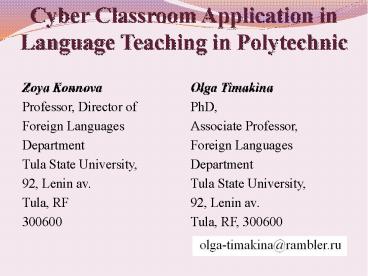Cyber Classroom Application in Language Teaching in Polytechnic - PowerPoint PPT Presentation
Title:
Cyber Classroom Application in Language Teaching in Polytechnic
Description:
Internet-technologies provide a variety of didactic opportunities to perfect ... meet the principles of communicativeness, authenticity and student's autonomy. ... – PowerPoint PPT presentation
Number of Views:130
Avg rating:3.0/5.0
Title: Cyber Classroom Application in Language Teaching in Polytechnic
1
Cyber Classroom Application in Language Teaching
in Polytechnic
- Zoya Konnova
- Professor, Director of
- Foreign Languages
- Department
- Tula State University,
- 92, Lenin av.
- Tula, RF
- 300600
- Olga Timakina
- PhD,
- Associate Professor,
- Foreign Languages
- Department
- Tula State University,
- 92, Lenin av.
- Tula, RF, 300600
2
- Internet-technologies provide a variety
of didactic opportunities to perfect University
students training. However, the teachers still
experience the scarcity of specific technical
approach in Internet application while teaching
students.
3
- To solve the stated problem it is
necessary to define the functions of the
educational information-communication
environment, Internet in particular, where the
foreign language is taught practically.
4
- Depending on the priorities of the
student group the English language teacher can
easily select among the multitude of different
guidelines, activities and work directions
provided by the Internet. They are - Home reading and report preparation infotainment
- On-line dictionaries
- On-line testing
- E-mail technology for developing writing skills
- CAVOCA for vocabulary learning.
5
Home reading and report preparation infotainment
- The students are provided with the route
guide of the cyber classroom lesson, so as they
can choose the comfortable work pace for
themselves and, if necessary, go back to the
Internet sites they need.
6
Route Guide of the Cyber Classroom Lesson
- newspapers and magazines
- economist.com
- ft.com
- japantimes.co.jp
- subject sites
- business.com
- fastcompany.com
- bpubs.com
- academic books
- longman-elt.com
- catalogue-sites
- worldpress.org
- asiaobserver.com
7
On-line dictionaries
- The number of lexical items in on-line
dictionaries differ from the lists of 200-400
words to the solid Internet sites containing
4000-8000 lexical items. To see all possible
on-line dictionaries, please, go to
8
On-line testing
- General English Tests
- Students should do 2-3 tests to check their
basic knowledge of grammar and vocabulary.
- Business English Tests
- Business English tests are designed to control
simultaneously the knowledge of basic English,
economic vocabulary and professional vocabulary.
9
http//www.dialang.orgA sample of
Dialang test for controlling reading skills
10
E-mail technology for developing writing skills
- To create the competitive information
the students writing skills should be trained up
to the automatic level. When the students do the
written tasks in the Cyber classroom, their
motivation rises respectively. The students are
supplied with the set of tasks in the following
directions Business Letter Practice and Private
Letter Practice.
11
Computer Assisted Vocabulary Acquisition (CAVOCA)
- CAVOCA is an effective computer
programme for learning foreign vocabulary. The
programme allows to learn the words and their
meanings from the context with the minimum time
pricing, basing on the word acquisition process
in the mother tongue. - There are 4 sections in CAVOCA.
12
Section I Deduction
- The word to be learned appears on the
screen for a few seconds. Next, it is used in
three sentences, presented in order of contextual
richness.
13
Section II Usage
- Usage is geared to the second stage of
the word acquisition process, consolidation. To
further secure the words position in the mental
lexicon and to further illustrate its exact
meaning, two sentences are presented in which the
word is either used correctly/appropriately or
not. The learner chooses and the computer gives
feedback, explaining why the use of the word in
question in that particular context was correct
or incorrect.
14
(No Transcript)
15
(No Transcript)
16
Section III Examples
- Examples, is likewise designed to
reinforce consolidation and thus ensure long term
retention. The learner is presented with a number
of authentic passages selected from large
databases containing the word just learned. These
passages have been specially selected to clearly
illustrate both meaning and use of the word in
question.
17
(No Transcript)
18
Section IV Lexical Retrieval
- In this section, which also serves as a
self-assessment test, the learners active
knowledge of the word is elicited. The learner is
presented with 25 sentences, each with one word
missing. These sentences have been selected
specially so that the blank can be filled by one
word only (i.e., one of the words covered in the
module). To help the learner and to elicit
specifically the word recently acquired, the
first letter of the word belonging in the
sentence is given. Once the 25 sentences have
been completed, the learners score appears on
the screen and any mistakes are pointed out.
19
(No Transcript)
20
- To sum it up, the usage of
Internet-technologies together with the
traditional forms and methods of education in the
Cyber Classroom allows to raise efficiency and
motivation in a process of foreign language
learning. The methodology of IT application in
foreign language teaching must meet the
principles of communicativeness, authenticity and
students autonomy.

